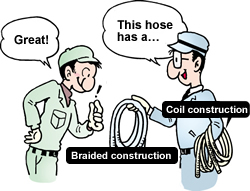Hose and Coupling Knowledge Base
If You Register to Become a Web Member, We Will Send You the Latest Information on Hoses and Coupling.
The Benefits of the Right Hose for the Situation (2)

Different constructions give each type of hose different characteristics.
The most basic difference has to do with whether the hose is made of a single layer or multiple layers. Single-layer hoses are of course made with a single type of material. These can be used in situations where no pressure is applied during use.
The multiple-layer hoses come in three types:
1. hoses with different materials on the inside and outside to provide various characteristics, 2. hoses with threads woven into the middle layer, and 3. hoses with a construction of metal or plastic wire.
1. With the first type, different colors of hoses can be used to indicate the fluid inside or the direction of flow. Also, a combination of chemical resistance and flexibility is made possible using a fluororesin inside and a vinyl chloride construction on the outside.
2. The braided construction of the second type provides high pressure resistance for high-speed conveyance. This type is not made to withstand negative pressure (suction), however.
> Click here for information about flexible hose constructions to reduce connection problems
3. The third type features coiled reinforcement for resistance against crushing to maintain a flow path even when the hose is bent tightly. These can handle fluids even in a suction as they do not buckle under negative pressure. They are not as resistant to pressure, however, as the braided type.
For assistance in selecting the best hoses and couplings for your situation: http://english.toyox-hose.com/index.html
Archive
How to Cut Steel-Wire-Reinforced PVC Hose
Does Electricity Conservation Increase Condensation?
Why Do Hoses Leak & Disconnect?
Can PVC & Other Plastic Hoses Be Used for Fuel Gas & Kerosene?
How to Read Catalog Specifications, Part 4 – Are Hose Sizes Random?
How to Read Catalog Specifications, Part 3 – Minimum Bend Radius
Beware of Static Electricity on Hoses
How to Read Catalog Specifications, Part 2 – Negative Pressure+B10
About REACH, RoHS, Endocrine Disruptor & the Food Sanitation Act
How to Read Catalog Specifications, Part 1 – Use Pressure
How to Avoid Damage Caused by Ultraviolet Rays
The Dangers of Hose Condensation
Why Transparent Hoses Become Cloudy
Leaks & Disconnections Due to Mismatched Couplings & Hoses
Causes & Solutions for Leaks & Disconnections
The Benefits of the Right Hose for the Situation (2)









